Fabien (Thaddeus) Gottleib von Bellingshausen
Vostok
and Mirnyi 1819- 1821
A Russian expedition of world exploration and discovery that visited the Antarctic ocean twice, there is a very strong chance these were the first ships to see and discover continental Antarctica on January the 28th 1820 though no landing was made.
The Crew
Vostok (East) Officers
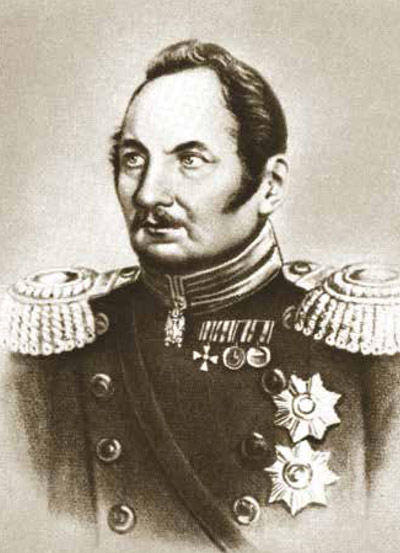
von Bellingshausen, Fabien Gottleib
Chief of the
expedition and Captain of the
Vostok
Adams, Roman - Midshipman
Bergh, Jacob - Staff-surgeon
Demidov, Dimitri - Sub-lieutenant
Ignatiev, Ivan - Lieutenant
Lyaskov, Arcady - Lieutenant
Mikhailov, Pavel Nikolaevich -
Artist
Paryadin,Jacob - Navigating
officer
Rezanov, Ivan - paymaster
with rank of officer
Siminov,
Ivan - Astronomer
Torsen, Constantin
- Lieutenant
Zavodovski,
Ivan - Lieutenant Commander
Mirnyi (Peaceful) Officers
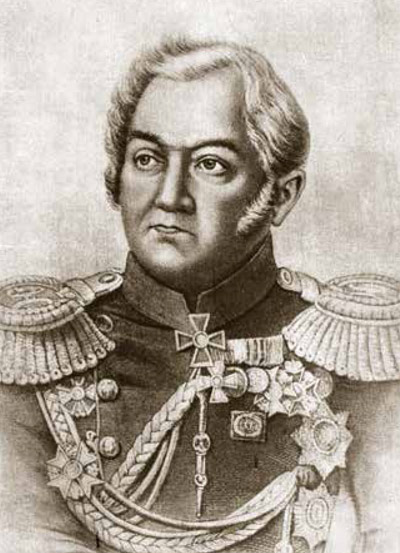
Lazarev, Mikhail
Lieutenant (in command)
Annenkov, Nikolai - Lieutenant
Galkin, Nikolai - Surgeon
Ilin, Nikolai - Navigating officer
Kupriyanov, Ivan - Sub-lieutenant
Novosilski, Paul - Sub-lieutenant
Obernibessov, Nikolai - Lieutenant
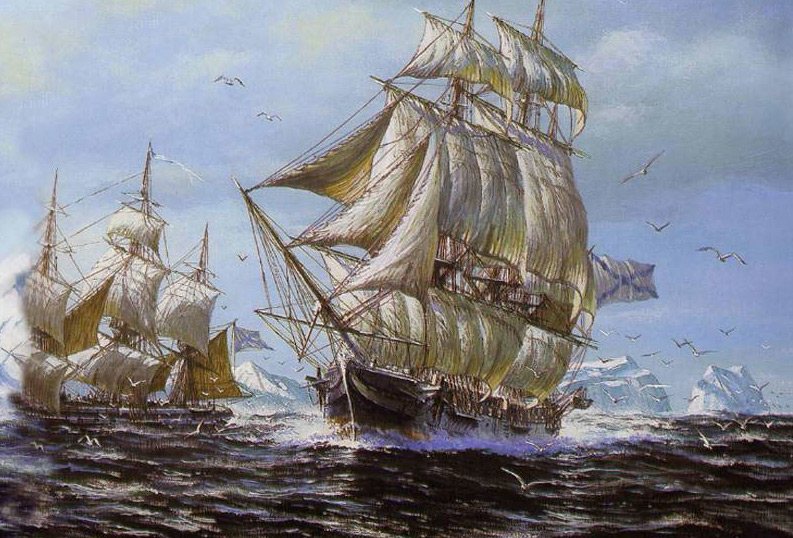 The
Vostok and Mirny in Antarctic waters
The
Vostok and Mirny in Antarctic waters
Shortly after Napoleon had been dispatched from Moscow in 1812, the Emperor Alexander Pavlovich (Tsar Alexander I) for an assortment of reasons including the annexation of new lands for the Russian Empire, but also as a result of his own instabilities decreed that two expeditions be dispatched of two vessels each to the higher latitudes of the Arctic and Antarctic Oceans.
A Captain Ratmanov was originally selected for the voyage, though withdrew due to ill health and so Bellingshausen was appointed to be commander of the southern expedition with only 6 weeks notice in April 1819. He was a great admirer of Captain James Cook and it would no doubt have given him immense pleasure to hear the words of the Antarctic historian Hugh Robert Mill (1861-1950) that his journey to Antarctica in the Vostok and Mirnyi was:
"One
of the greatest Antarctic expeditions on record,
a voyage
well worthy of being placed beside that of Cook"
The 600 ton corvette Vostok had been built only a year earlier and was the larger of the two vessels at 130 feet with a 33 foot beam and 10 foot draft, it had a coppered hull though was not ice strengthened. The 530 ton Mirnyi (previously Ladoga) 120 feet long with a 33 foot beam was an ex transport sloop, coppered like the Vostok, and also strengthened for ice work. The Mirnyi was a poor sailing vessel and despite mast and sail changes was considerably slower than the Vostok which spent much of the 2 year voyage under abridged sail to allow the slower Mirnyi to keep up.
Despite the anticipated hardships and risks, there
were many volunteers to go on the voyage, a pattern that characterizes
all of the early Antarctic Expeditions and even down to the
present day. Great efforts were made in the selection
of provisions and other supplies with salted beef, wheat and
rye biscuits, sauerkraut (pickled cabbage) beef tea tablets
and many other preserved foodstuffs.
Pay and allowances - each member of the expedition was paid 8 times the normal amount, in addition to this, officers and scientists were given a mess allowance. Before departure, the Tsar awarded Bellingshausen a gratuity of 5 thousand Roubles and for the journey from the Black Sea to the Baltic, a thousand Roubles. Three thousand Roubles were awarded to Lieutenant Lazarev (commander of the Mirnyi) and a year's pay to all the officers and men.
note - webmaster - the best value I can find for the time is that a manual worker on land on par with a sailor would be earning in the region of 500 Roubles a year.
There were to have been two German naturalists joining the expedition at Copenhagen, but they declined at the last moment. Bellingshausen, concerned that he could not carry out the scientific programme appealed to Sir Joseph Banks in England who had sailed with Captain Cook and to the Royal Society, though no last-minute recruits were available.
The expedition crossed the Antarctic Circle (the first to do so since Cook) on January 26, 1820. On January 28 1820 the expedition discovered the Antarctic mainland approaching the Antarctic coast at a point with coordinates 69° 14' W seeing ice-fields there. Bellingshausen's diary, his report to the Russian Naval Minister on 21 July 1821 and other documents available in the Russian State Museum of the Arctic and Antarctic in Saint Petersburg Russia all support this fact.
The evidence points to Bellingshausen being the discoverer of the sought-after Terra Australis - rather than the Royal Navy's Edward Bransfield just two days later on the 30th of January 1820 or the American Nathaniel Palmer later the same year on the 17th of November 1820.
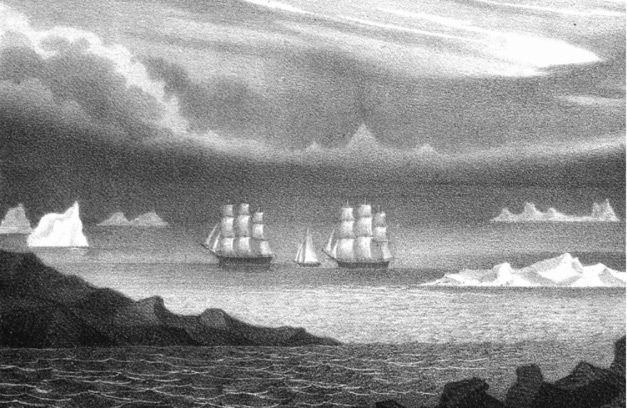
Vostok and Mirny meet Nathaniel Palmer and his sloop Hero at
the South Shetland Islands
In 1821, the Vostok and Mirny re-visited Antarctica sailing the other half of their circumnavigation. On February the 6th 1821 the ships were sailing in the South Shetland Islands when a ship's bell was heard through the fog which they answered with their own to the astonishment of American Nathaniel Palmer on his sealing sloop Hero. There were eight sealing vessels met this day both American and British. With the sighting and discovery of the Antarctic continent a year earlier and so many sealers looking for new hunting grounds it seems almost impossible that none of them landed on continental Antarctica, though there no records kept of any having done so.
During the voyage Bellingshausen also discovered and named Peter I Island and a peninsula of the Antarctic mainland which he named the Alexander Coast but which has more recently borne the designation of Alexander Island.
The expedition lasted 751 days, 527 of which were spent under sail, they had covered upwards of 57,000 miles, more than twice round the equator.
Other crew:
Vostok
Second mates with rank of petty officer
- 2
Assistant Mate with rank of petty
officer - 1
Boatswain - 1
Quartermasters - 4
Bugler -
1
Seamen - 71
Drummer -
1
Steward - 1
Assistant surgeon -
1
Carpenter (2nd class) - 2
Carpenter's
apprentice (2nd class) - 1
Locksmith
- 1
Caulker - 1
Sailmaker
- 1
Cooper - 1
Gunnery
petty officers - 2
Bombardier -
1
Gunners (1st grade) - 11
Total compliment = 116
Mirnyi
Second mate with rank of petty officer
- 1
Assistant Mate - 1
Boatswain - 1
Quartermasters -
2
Seamen (1st class) - 44
Drummer
- 1
Steward - 1
Assistant
surgeon - 1
Carpenters -
2
Locksmith - 1
Caulker -
1
Sailmaker - 1
Cooper -
1
Gunnery petty officer - 1
Gunners
(1st grade) - 6
Total compliment = 72
The men were unusually well clothed, with each receiving the following:
- Sailors uniforms with cloth jacket - 4
- Shoes - 4 pairs
- Summer trousers of Flemish linen - 6
- Working trousers of dimity (coarse cotton) - 4
- Working coats of dimity - 4
- Trousers of cloth - 2
- Overcoat of grey cloth - 1
- Fur cap (for warmth) - 1
- Hat - 1
- Warm boots lined with cloth - 1 pair
- Blanket -1
- Bed - 1
- Pillow - 1
- Sheets - 4
- Woollen stockings - 8
- Linen shirts - 11
- Flannel shirts - 7
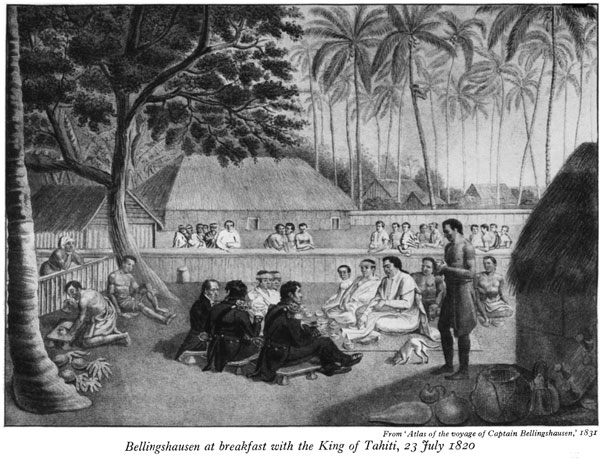 Bellingshausen
at breakfast with the King of Tahiti, 23 July 1820
Bellingshausen
at breakfast with the King of Tahiti, 23 July 1820
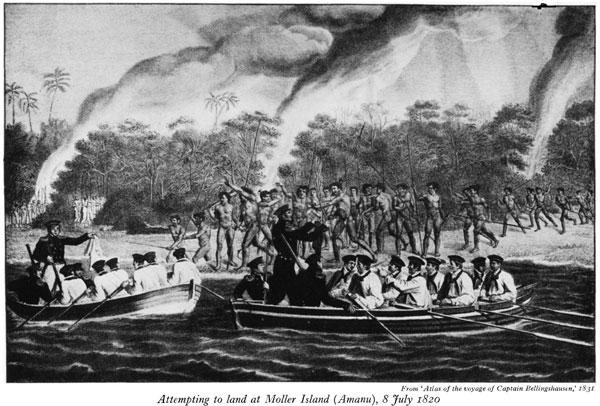 Attempting
to land at Moller Island (Amanu), 8 July 1820
Attempting
to land at Moller Island (Amanu), 8 July 1820
South
Pacific
Reference - Debenham, F, (Ed), 1945 The Voyage of Captain
Bellingshausen to the Antarctic Seas
1819-1821, Hakluyt Society,
London, pp 364-372.
Biographical information
- I am concentrating on the Polar experiences of the men involved.
Any further information or pictures visitors may have will be gratefully received.
Please email
- Paul Ward, webmaster.
What are the chances that my ancestor was an unsung part of the Heroic Age
of Antarctic Exploration?
